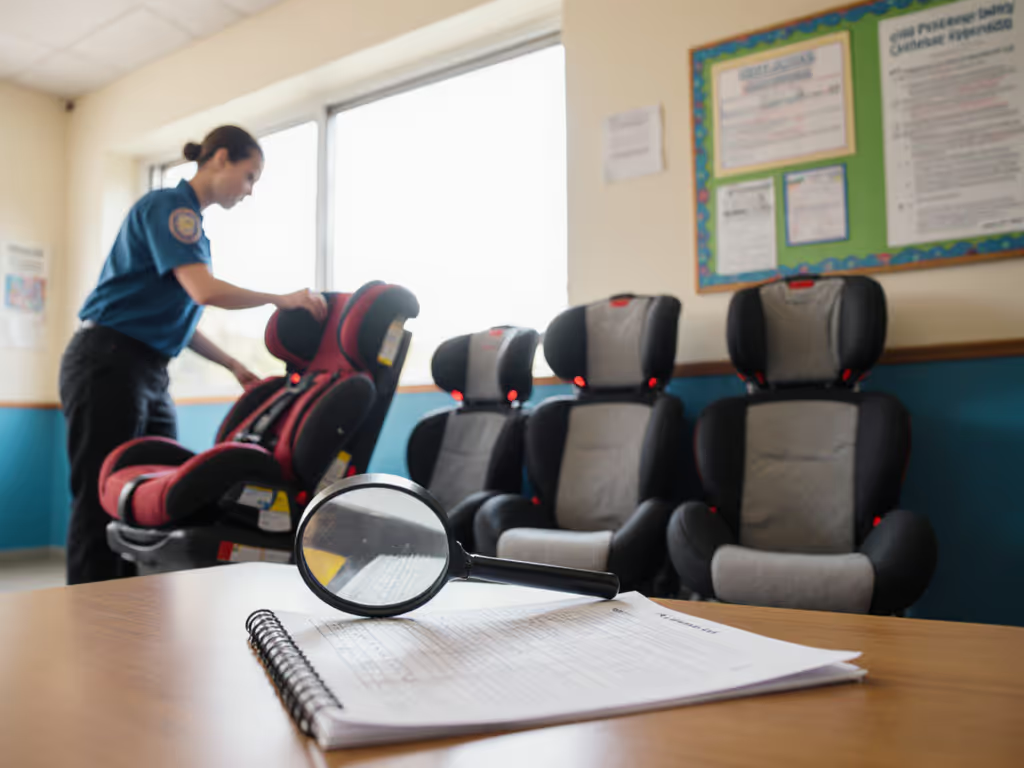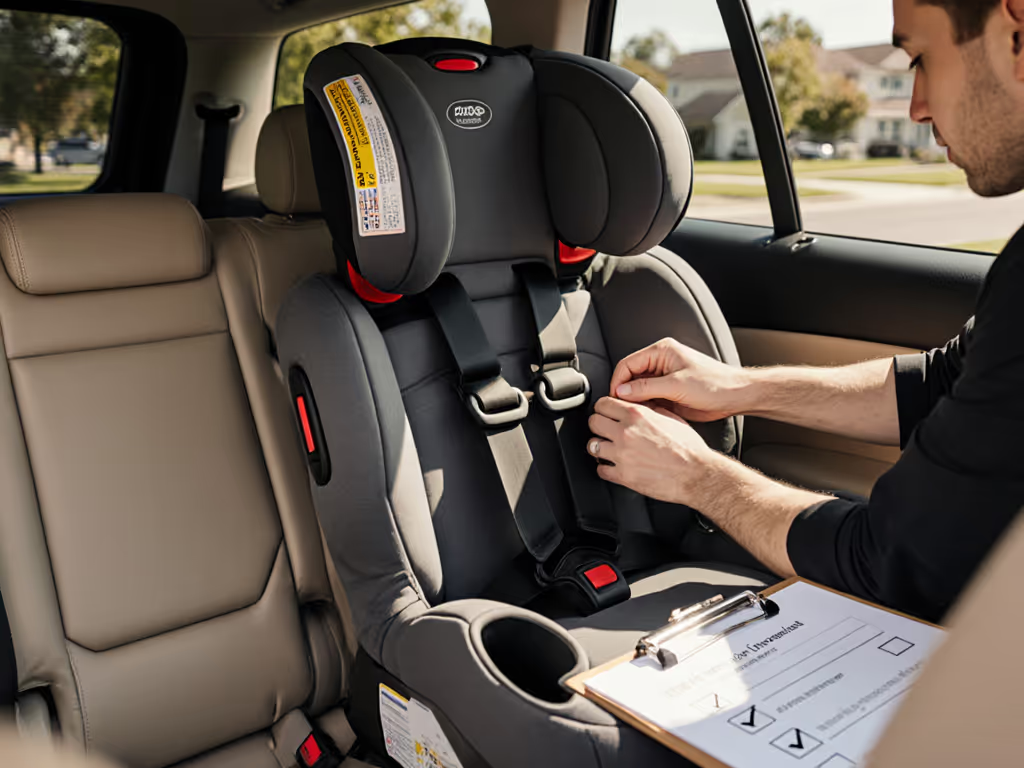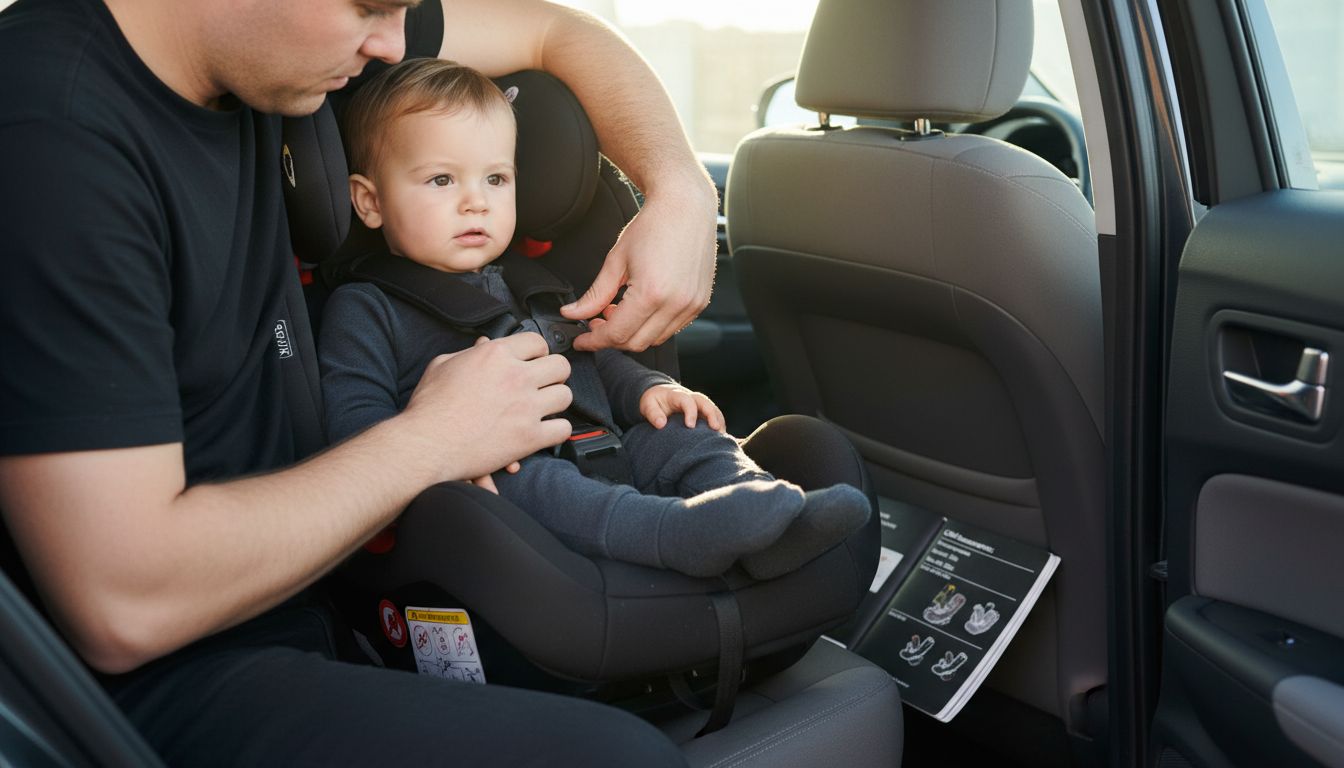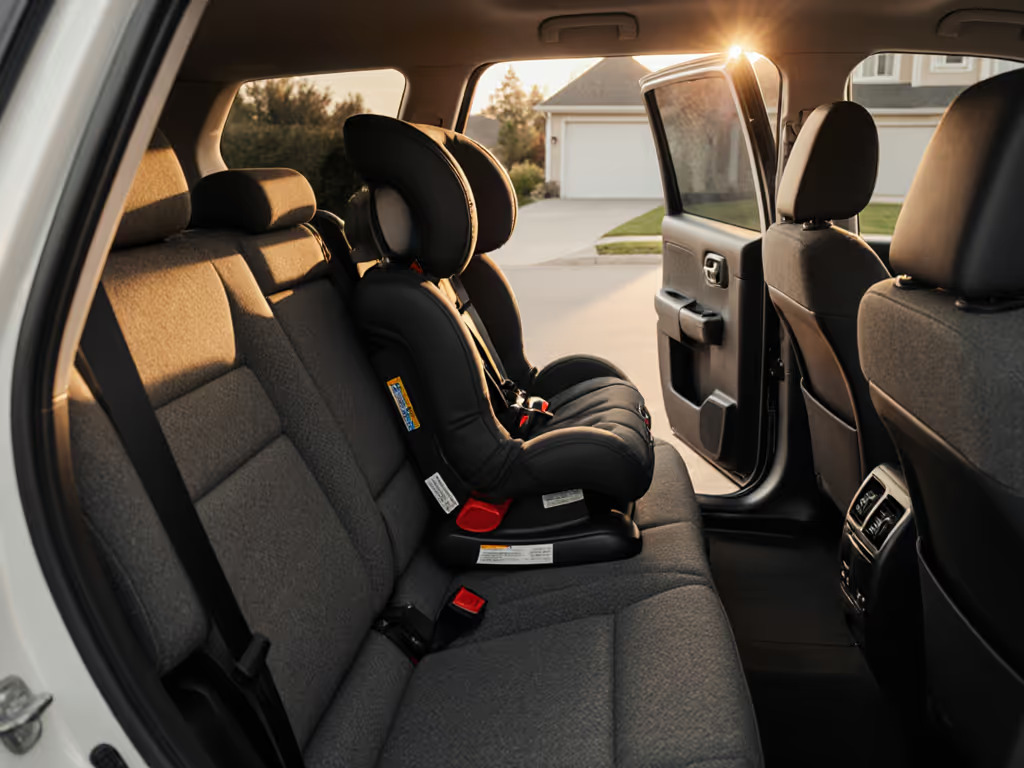
Car Seat Safety Checklist 2025: Ensure Maximum Protection

Child safety experts agree new regulations make a dramatic difference on the road. With international standards evolving and more countries requiring rear facing seats for longer periods, keeping up with these changes is vital for any parent. Knowing that a properly installed and selected car seat can reduce injury risk by up to 71 percent, you want every advantage possible. This step by step guide brings clarity to current rules and helps you make safe, informed choices for your child.
Quick Summary
| Key Point | Explanation |
|---|---|
| 1. Review current car seat standards | Stay updated on evolving safety regulations to ensure child protection during travel. |
| 2. Inspect seat and vehicle compatibility | Confirm your car seat matches your child's measurements and your vehicle's requirements for maximum safety. |
| 3. Install seat following instructions | Proper installation is crucial; always adhere to the specific guidelines provided by manufacturers. |
| 4. Secure your child correctly | Ensure the harness is adjusted snugly, with correct strap positioning for optimal safety during travel. |
| 5. Verify installation with a wiggle test | Perform a wiggle test to check that the seat is secure and inspect for any visible damage or recalls. |
![]()
Step 1: Review latest car seat safety standards
Reviewing the most current car seat safety standards is critical for protecting your child during travel. This step will help you understand the evolving regulations that keep children safer on the road.
Recent international developments provide important insights into emerging safety guidelines. In November 2024, China adopted groundbreaking standards requiring children under 15 months to use rear or side-facing child restraints. Similarly, Vietnam is implementing a comprehensive child safety law starting January 2026 that mandates approved child restraint systems for children under 10 years old or shorter than 1.35 meters.
To review safety standards effectively, start by checking official transportation and child safety websites from national transportation departments. Look specifically for updates on:
- Recommended seating positions
- Age and weight requirements
- Impact protection specifications
- Rear facing duration recommendations
Pay special attention to guidelines about rear facing seats. Many safety experts now recommend keeping children rear facing as long as possible given the significantly higher protection these configurations provide during potential collisions. While regulations vary by region, the trend is moving toward extended rear facing periods to maximize child safety.
Warning: Safety standards change frequently. What was considered acceptable two years ago might now be outdated. Always verify the most recent guidelines and consult certified child passenger safety technicians for personalized advice specific to your vehicle and child's measurements.
Step 2: Inspect seat compatibility with child and vehicle
Inspecting seat compatibility involves carefully matching your car seat to both your child's physical measurements and your specific vehicle requirements. This crucial step ensures maximum safety and proper installation for your young passenger.
Start by gathering three key sets of information. First, review your child's current height, weight, and age. The Centers for Disease Control recommends checking both car seat and vehicle manuals meticulously to confirm weight limits and installation methods. Second, examine your vehicle's interior layout and available anchor points. The international Isofix standard provides standardized attachment points that can simplify secure installation without relying solely on seat belts.
Measure and compare critical dimensions carefully. Check the car seat's weight range against your child's current measurements. Look for Isofix compatible anchor points in your vehicle which provide a more stable and straightforward connection. Some modern vehicles feature multiple anchor configurations specifically designed for child safety seats.
Pay close attention to specific compatibility details:
- Precise weight and height limits
- Seat belt path requirements
- Available lower anchor points
- Seat angle specifications
- Clearance for front and rear seats
Warning: Compatibility is not universal. A seat that works perfectly in one vehicle might be challenging or unsafe in another. Always perform a physical test fitting and consider consulting a certified child passenger safety technician for personalized verification.

After confirming compatibility, you are ready to move forward with confident installation knowing you have selected the safest possible configuration for your child.
Step 3: Install car seat following manufacturer instructions
Installing a car seat requires precision and careful attention to detail. This step transforms your vehicle into a safe transportation environment for your child by ensuring the seat is secured correctly.
The Centers for Disease Control emphasizes the critical importance of following both car seat and vehicle manufacturer instructions meticulously. Begin by thoroughly reading both instruction manuals side by side. Pay close attention to specific installation requirements for your particular seat and vehicle model. The Isofix standardized attachment system can simplify this process by providing clear connection points that reduce the risk of incorrect installation.
Start with the base placement. Position the car seat in the recommended location typically the rear seat and ensure it sits level and stable. For rear facing seats which are recommended for younger children use the built in level indicators to confirm proper angle. When using Isofix anchors listen for the audible click that indicates a secure connection.
Key installation steps include:
- Checking seat angle using built in level indicators
- Verifying tight and secure connection points
- Ensuring minimal side to side movement
- Confirming proper seat belt or anchor system engagement
- Double checking all locking mechanisms
Warning: Even a small installation error can compromise your childs safety. If you feel uncertain about the installation process do not hesitate to seek help from a certified child passenger safety technician who can provide hands on guidance.
Once installed perform a final wiggle test. The car seat should not move more than one inch in any direction when firmly pushed. This final check provides confidence that your child will be securely protected during every journey.
Step 4: Secure your child correctly in the seat
Securing your child in the car seat is a critical safety process that requires precision and careful attention to detail. This step ensures your child is protected and comfortable during every journey.
According to the Centers for Disease Control guidelines, proper harness placement is fundamental to child safety. For rear facing seats, position the harness straps at or below your child's shoulders. If the seat is forward facing the straps should be at or above shoulder level. The chest clip is another crucial element that must be positioned precisely at armpit level to distribute the harness forces correctly.
Start by dressing your child in thin layers that allow the harness to sit close to their body. Bulky clothing can create dangerous slack in the harness system. Gently place your child in the seat and begin adjusting the straps. The harness should be snug enough that you cannot pinch any excess material at the shoulder area. When you think the straps are tight enough try the pinch test pull the straps to ensure minimal movement.
Key steps for correct harness securing:
- Check strap positioning relative to shoulders
- Ensure chest clip is at armpit level
- Remove any slack in the harness system
- Confirm straps lie flat without twists
- Verify child sits centered in the seat
Warning: Never rush the harness securing process. A loose or improperly positioned harness can significantly reduce protection during a collision. Take your time to adjust and double check every connection.
Once secured perform a final comfort and safety check. Your child should be snug but not restricted with the harness lying smoothly against their body. This meticulous approach transforms the car seat from a mere accessory into a critical safety shield for your most precious passenger.
Step 5: Verify proper installation and safety compliance
Verifying your car seat installation is the final critical step in ensuring your child's maximum protection during travel. This comprehensive check transforms your careful installation into a reliable safety system.
The Centers for Disease Control provides clear guidelines for installation verification. First perform the critical wiggle test. Grab the car seat at its base and attempt to move it side to side and front to back. A properly installed seat should not move more than one inch in any direction. This minimal movement indicates a secure connection that will protect your child during unexpected impacts.
Conduct a systematic safety inspection that goes beyond simple movement testing. Check the harness system for proper tension and positioning. Examine the seat for any signs of wear damage or stress. Review the manufacturers documentation to confirm your specific model meets current safety standards and has not been subject to any recent recalls.
Key verification steps include:
- Performing the one inch wiggle test
- Checking harness tension and positioning
- Inspecting seat for visible damage
- Verifying current safety certifications
- Confirming no active manufacturer recalls
Warning: Even small installation errors can compromise safety. If you have any doubt about the installation consider scheduling a professional inspection with a certified child passenger safety technician who can provide expert verification.
A thorough verification process provides peace of mind. You have now transformed your car seat from a simple accessory into a carefully engineered protection system designed to keep your most precious passenger safe during every journey.
Upgrade Your Child's Safety with Expert Guidance and Perfect Fit
The article "Car Seat Safety Checklist 2025: Ensure Maximum Protection" highlights the complex challenge every caregiver faces: confidently navigating evolving safety standards, ensuring seat and vehicle compatibility, and mastering precise installation and harness securing. These tasks are not simple, and the emotional weight of keeping your precious child safe on every journey cannot be overstated. Are you sure your current car seat setup meets the latest recommendations for maximum protection and comfort?
At Fits for Years Seats, we understand these critical pain points and provide tailored solutions that bridge knowledge and action. From personalized advice based on your child's size and your vehicle model to detailed, research-driven guides on installation and safety compliance, our website empowers you to make the safest choices now. Don’t wait to learn how you can avoid costly mistakes and ensure a secure fit with our comprehensive resources. Start now by visiting Fits for Years Seats and take the first step toward hassle-free, expert car seat safety today.
Frequently Asked Questions
How can I review the latest car seat safety standards for 2025?
To review the latest car seat safety standards, check the official transportation and child safety websites, focusing on updates related to age, weight requirements, and seating positions. Ensure to look for recommendations specific to rear-facing seats, as these provide enhanced protection for younger children.
What steps should I take to inspect car seat compatibility?
Inspect car seat compatibility by measuring your child's height, weight, and age, and comparing these with the car seat's specifications. Additionally, examine your vehicle’s interior for available anchor points that ensure a secure fit for the car seat.
How do I install a car seat correctly?
To install a car seat correctly, follow both the car seat and vehicle manufacturer’s instructions closely. Focus on the base placement in the rear seat, ensure it is level, and check that the seat is securely anchored using the provided Isofix points or seat belts.
What are the key steps to secure my child correctly in the car seat?
Secure your child correctly by adjusting the harness straps based on their shoulder height: at or below for rear-facing and at or above for forward-facing. Make sure the chest clip is at armpit level, and ensure the harness is snug, allowing for no more than one inch of excess material at the shoulders.
How do I verify proper installation and safety compliance of the car seat?
Verify proper installation by performing the wiggle test; the car seat should not move more than one inch in any direction when tested at the base. Additionally, check the harness tension, inspect for visible damage, and confirm that your model meets safety certifications and isn’t subject to recalls.
What should I do if I'm uncertain about my car seat installation?
If you're uncertain about the car seat installation, consider scheduling an inspection with a certified child passenger safety technician. They can provide expert hands-on guidance to ensure your installation meets safety standards.




